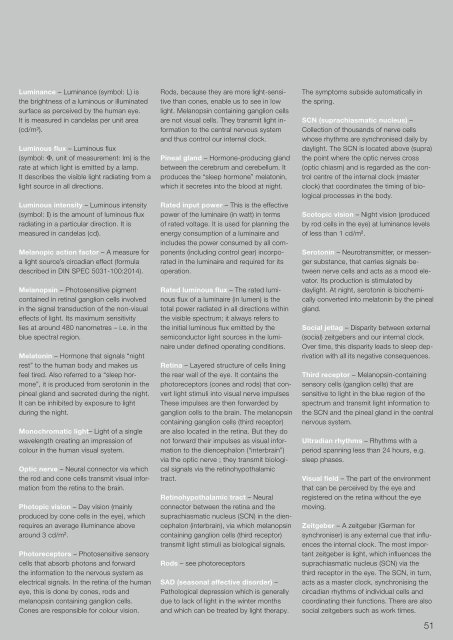licht.wissen 19 No. "Impact of Light on Human Beings"
Light synchronises our “internal clock”. Lighting that copies daylight has more than just a visual impact; it supports bodily functions 24 hours a day. Booklet 19 is intended for all those who want to delve into the topic of Impact of Light on Human Beings. The 56 pages helps to get an overview of what melanopic light can effect. Free Download at www.licht.de/en
Light synchronises our “internal clock”. Lighting that copies daylight has more than just a visual impact; it supports bodily functions 24 hours a day. Booklet 19 is intended for all those who want to delve into the topic of Impact of Light on Human Beings. The 56 pages helps to get an overview of what melanopic light can effect. Free Download at www.licht.de/en
You also want an ePaper? Increase the reach of your titles
YUMPU automatically turns print PDFs into web optimized ePapers that Google loves.
Luminance – Luminance (symbol: L) is<br />
the brightness <str<strong>on</strong>g>of</str<strong>on</strong>g> a luminous or illuminated<br />
surface as perceived by the human eye.<br />
It is measured in candelas per unit area<br />
(cd/m²).<br />
Luminous flux – Luminous flux<br />
(symbol: , unit <str<strong>on</strong>g>of</str<strong>on</strong>g> measurement: lm) is the<br />
rate at which light is emitted by a lamp.<br />
It describes the visible light radiating from a<br />
light source in all directi<strong>on</strong>s.<br />
Luminous intensity – Luminous intensity<br />
(symbol: ) is the amount <str<strong>on</strong>g>of</str<strong>on</strong>g> luminous flux<br />
radiating in a particular directi<strong>on</strong>. It is<br />
measured in candelas (cd).<br />
Melanopic acti<strong>on</strong> factor – A measure for<br />
a light source’s circadian effect (formula<br />
described in DIN SPEC 5031-100:2014).<br />
Melanopsin – Photosensitive pigment<br />
c<strong>on</strong>tained in retinal gangli<strong>on</strong> cells involved<br />
in the signal transducti<strong>on</strong> <str<strong>on</strong>g>of</str<strong>on</strong>g> the n<strong>on</strong>-visual<br />
effects <str<strong>on</strong>g>of</str<strong>on</strong>g> light. Its maximum sensitivity<br />
lies at around 480 nanometres – i.e. in the<br />
blue spectral regi<strong>on</strong>.<br />
Melat<strong>on</strong>in – Horm<strong>on</strong>e that signals “night<br />
rest” to the human body and makes us<br />
feel tired. Also referred to a “sleep horm<strong>on</strong>e”,<br />
it is produced from serot<strong>on</strong>in in the<br />
pineal gland and secreted during the night.<br />
It can be inhibited by exposure to light<br />
during the night.<br />
M<strong>on</strong>ochromatic light– <str<strong>on</strong>g>Light</str<strong>on</strong>g> <str<strong>on</strong>g>of</str<strong>on</strong>g> a single<br />
wavelength creating an impressi<strong>on</strong> <str<strong>on</strong>g>of</str<strong>on</strong>g><br />
colour in the human visual system.<br />
Optic nerve – Neural c<strong>on</strong>nector via which<br />
the rod and c<strong>on</strong>e cells transmit visual informati<strong>on</strong><br />
from the retina to the brain.<br />
Photopic visi<strong>on</strong> – Day visi<strong>on</strong> (mainly<br />
produced by c<strong>on</strong>e cells in the eye), which<br />
requires an average illuminance above<br />
around 3 cd/m 2 .<br />
Photoreceptors – Photosensitive sensory<br />
cells that absorb phot<strong>on</strong>s and forward<br />
the informati<strong>on</strong> to the nervous system as<br />
electrical signals. In the retina <str<strong>on</strong>g>of</str<strong>on</strong>g> the human<br />
eye, this is d<strong>on</strong>e by c<strong>on</strong>es, rods and<br />
melanopsin c<strong>on</strong>taining gangli<strong>on</strong> cells.<br />
C<strong>on</strong>es are resp<strong>on</strong>sible for colour visi<strong>on</strong>.<br />
Rods, because they are more light-sensitive<br />
than c<strong>on</strong>es, enable us to see in low<br />
light. Melanopsin c<strong>on</strong>taining gangli<strong>on</strong> cells<br />
are not visual cells. They transmit light informati<strong>on</strong><br />
to the central nervous system<br />
and thus c<strong>on</strong>trol our internal clock.<br />
Pineal gland – Horm<strong>on</strong>e-producing gland<br />
between the cerebrum and cerebellum. It<br />
produces the “sleep horm<strong>on</strong>e” melat<strong>on</strong>in,<br />
which it secretes into the blood at night.<br />
Rated input power – This is the effective<br />
power <str<strong>on</strong>g>of</str<strong>on</strong>g> the luminaire (in watt) in terms<br />
<str<strong>on</strong>g>of</str<strong>on</strong>g> rated voltage. It is used for planning the<br />
energy c<strong>on</strong>sumpti<strong>on</strong> <str<strong>on</strong>g>of</str<strong>on</strong>g> a luminaire and<br />
includes the power c<strong>on</strong>sumed by all comp<strong>on</strong>ents<br />
(including c<strong>on</strong>trol gear) incorporated<br />
in the luminaire and required for its<br />
operati<strong>on</strong>.<br />
Rated luminous flux – The rated luminous<br />
flux <str<strong>on</strong>g>of</str<strong>on</strong>g> a luminaire (in lumen) is the<br />
total power radiated in all directi<strong>on</strong>s within<br />
the visible spectrum; it always refers to<br />
the initial luminous flux emitted by the<br />
semic<strong>on</strong>ductor light sources in the luminaire<br />
under defined operating c<strong>on</strong>diti<strong>on</strong>s.<br />
Retina – Layered structure <str<strong>on</strong>g>of</str<strong>on</strong>g> cells lining<br />
the rear wall <str<strong>on</strong>g>of</str<strong>on</strong>g> the eye. It c<strong>on</strong>tains the<br />
photoreceptors (c<strong>on</strong>es and rods) that c<strong>on</strong>vert<br />
light stimuli into visual nerve impulses<br />
These impulses are then forwarded by<br />
gangli<strong>on</strong> cells to the brain. The melanopsin<br />
c<strong>on</strong>taining gangli<strong>on</strong> cells (third receptor)<br />
are also located in the retina. But they do<br />
not forward their impulses as visual informati<strong>on</strong><br />
to the diencephal<strong>on</strong> (“interbrain”)<br />
via the optic nerve ; they transmit biological<br />
signals via the retinohypothalamic<br />
tract.<br />
Retinohypothalamic tract – Neural<br />
c<strong>on</strong>nector between the retina and the<br />
suprachiasmatic nucleus (SCN) in the diencephal<strong>on</strong><br />
(interbrain), via which melanopsin<br />
c<strong>on</strong>taining gangli<strong>on</strong> cells (third receptor)<br />
transmit light stimuli as biological signals.<br />
Rods – see photoreceptors<br />
SAD (seas<strong>on</strong>al affective disorder) –<br />
Pathological depressi<strong>on</strong> which is generally<br />
due to lack <str<strong>on</strong>g>of</str<strong>on</strong>g> light in the winter m<strong>on</strong>ths<br />
and which can be treated by light therapy.<br />
The symptoms subside automatically in<br />
the spring.<br />
SCN (suprachiasmatic nucleus) –<br />
Collecti<strong>on</strong> <str<strong>on</strong>g>of</str<strong>on</strong>g> thousands <str<strong>on</strong>g>of</str<strong>on</strong>g> nerve cells<br />
whose rhythms are synchr<strong>on</strong>ised daily by<br />
daylight. The SCN is located above (supra)<br />
the point where the optic nerves cross<br />
(optic chiasm) and is regarded as the c<strong>on</strong>trol<br />
centre <str<strong>on</strong>g>of</str<strong>on</strong>g> the internal clock (master<br />
clock) that coordinates the timing <str<strong>on</strong>g>of</str<strong>on</strong>g> biological<br />
processes in the body.<br />
Scotopic visi<strong>on</strong> – Night visi<strong>on</strong> (produced<br />
by rod cells in the eye) at luminance levels<br />
<str<strong>on</strong>g>of</str<strong>on</strong>g> less than 1 cd/m 2 .<br />
Serot<strong>on</strong>in – Neurotransmitter, or messenger<br />
substance, that carries signals between<br />
nerve cells and acts as a mood elevator.<br />
Its producti<strong>on</strong> is stimulated by<br />
daylight. At night, serot<strong>on</strong>in is biochemically<br />
c<strong>on</strong>verted into melat<strong>on</strong>in by the pineal<br />
gland.<br />
Social jetlag – Disparity between external<br />
(social) zeitgebers and our internal clock.<br />
Over time, this disparity leads to sleep deprivati<strong>on</strong><br />
with all its negative c<strong>on</strong>sequences.<br />
Third receptor – Melanopsin-c<strong>on</strong>taining<br />
sensory cells (gangli<strong>on</strong> cells) that are<br />
sensitive to light in the blue regi<strong>on</strong> <str<strong>on</strong>g>of</str<strong>on</strong>g> the<br />
spectrum and transmit light informati<strong>on</strong> to<br />
the SCN and the pineal gland in the central<br />
nervous system.<br />
Ultradian rhythms – Rhythms with a<br />
period spanning less than 24 hours, e.g.<br />
sleep phases.<br />
Visual field – The part <str<strong>on</strong>g>of</str<strong>on</strong>g> the envir<strong>on</strong>ment<br />
that can be perceived by the eye and<br />
registered <strong>on</strong> the retina without the eye<br />
moving.<br />
Zeitgeber – A zeitgeber (German for<br />
synchr<strong>on</strong>iser) is any external cue that influences<br />
the internal clock. The most important<br />
zeitgeber is light, which influences the<br />
suprachiasmatic nucleus (SCN) via the<br />
third receptor in the eye. The SCN, in turn,<br />
acts as a master clock, synchr<strong>on</strong>ising the<br />
circadian rhythms <str<strong>on</strong>g>of</str<strong>on</strong>g> individual cells and<br />
coordinating their functi<strong>on</strong>s. There are also<br />
social zeitgebers such as work times.<br />
51

















